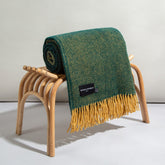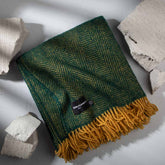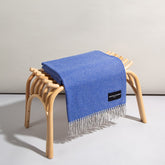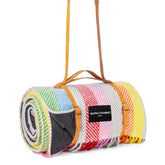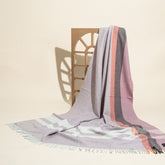Recycled Wool Blankets: A Sustainable Choice for Your Home
In today's era, where the consequences of our lifestyle choices echo louder than ever in the environment, opting for sustainable alternatives is not just a choice, but a pressing necessity. One such sustainable choice that blends seamlessly into our daily lives, offers warmth, comfort, and a style statement, all while being eco-friendly, is a recycled wool blanket.
Recycled wool blankets are a testament to the beauty and potential of reusing and repurposing. They offer a sustainable alternative to conventional blankets, championing both practicality and the preservation of our planet. This guide will delve into the concept, quality, and benefits of recycled wool blankets, equipping you with the knowledge to make an informed, eco-conscious choice for your home.
What Is a Recycled Wool Blanket?
A recycled wool blanket, as the name suggests, is a blanket made from recycled wool. Wool is a renewable resource, and its recycling process contributes to its sustainability. When wool garments or products reach the end of their lifespan, they are often discarded.

However, these items can be given a new lease of life through recycling. They are collected, sorted by color, and then shredded into fibers. These fibers are then cleaned, spun into new yarn, and woven or knitted into new items, such as our topic of interest - recycled wool blankets.
These blankets retain the natural benefits of wool - warmth, breathability, moisture-wicking properties, and durability, while also reducing waste and the need for new resources. They are typically characterised by a unique blend of colours due to the mixed source material, adding a touch of individuality to each piece.
The process of recycling wool into usable products
The process of recycling wool is intricate and involves several steps to ensure that the end product is of good quality.
Collection: First, old woolen garments, offcuts, or discarded wool products are collected.
Sorting: The collected wool is then sorted by colour. This step is crucial as it eliminates the need for re-dying the wool, saving water and energy.
Shredding: Once sorted, the wool is shredded or 'pulled' into fibres.
Cleaning and Blending: These fibres are then cleaned to remove any impurities. Often, they are blended with other fibres to improve their strength and durability.
Carding: The cleaned and blended fibres are then carded - a process of aligning the fibres to prepare them for spinning.
Spinning: The fibres are then spun into yarn.
Weaving/Knitting: Finally, this yarn is woven or knitted into new products, like recycled wool blankets.
The history and development of wool recycling
Wool recycling isn't a new concept. In fact, it has been practiced for centuries. Historically, old garments were often unraveled to retrieve the wool, which was then reused. This practice was particularly common during times of scarcity, such as war periods.
In recent years, with the rise in environmental awareness and advancements in technology, wool recycling has taken on a more industrial approach. Today, it serves as a vital part of the global effort to reduce waste and promote sustainable fashion and home goods. The recycled wool blanket is a perfect embodiment of this endeavour, transforming what was once waste into something warm, comfortable, and incredibly useful.
The Quality of Recycled Wool
When considering recycled wool, a common question that arises is about its quality. Many may wonder if recycled wool can match up to the quality of new wool. The answer lies in the process and care taken during the recycling stage.
The quality of recycled wool can indeed be excellent, and while it may depend on various factors such as the quality of the original wool, the recycling process, and whether the wool is blended with other fibres, it generally maintains the desirable characteristics of wool. These include its thermal properties, moisture-wicking capabilities, durability, and even its natural resistance to fire and odours.
However, it's worth noting that recycled wool may have a slightly shorter fibre length due to the recycling process, which can impact its feel and appearance. But this does not significantly degrade the quality or usefulness of the wool. In fact, recycled wool often boasts a unique character and charm that is hard to replicate with new wool.
Why Choose Recycled Wool Blankets
Environmental benefits
Recycled wool blankets bring a host of environmental benefits that make them an ideal choice for those who wish to make sustainable choices and minimise their environmental impact.
Reduced Waste and Landfill Contribution: By repurposing discarded woolen products, we can reduce waste and the need for landfill space. Wool is biodegradable, but it takes time to break down. Repurposing wool gives it a new life and keeps it functional and useful for a longer time.
Lower Carbon Footprint: The production process of recycled wool blankets has a lower carbon footprint compared to that of new wool blankets. This is primarily because recycling wool uses less water and energy compared to the process of producing new wool.

Conservation of Resources: Recycled wool reduces the demand for new wool, thereby conserving resources. It reduces the need for grazing land for sheep, as well as the energy and water required for rearing sheep and processing their wool.
Functional benefits
In addition to being environmentally friendly, recycled wool blankets also offer several functional benefits.
Durability and Longevity: Recycled wool blankets are robust and durable, often lasting for many years with proper care. This makes them a worthwhile investment for your home.
Warmth and Comfort: Recycled wool retains the excellent thermal regulation properties of wool, making these blankets warm and cozy. They can keep you comfortable in a variety of climates.
Aesthetics and Design Versatility: Due to the nature of the recycling process, recycled wool blankets often come in a range of unique and beautiful designs and colour combinations. This can add a touch of individuality and charm to your home décor.
Choosing recycled wool blankets means opting for sustainability without compromising on function or aesthetics. It is a choice that brings benefits for you, your home, and the environment.
Comparing Recycled Wool Blankets and Non-Recycled Wool Blankets
When it comes to choosing between recycled wool blankets and non-recycled wool blankets, we can take a closer look at their similarities and differences. Both options provide the natural benefits of wool, such as warmth, durability, and breathability, but there are key distinctions that might guide your choice.
Environmental Impact
The most significant difference between recycled and non-recycled wool blankets lies in their environmental impact. As discussed earlier, recycled wool blankets significantly reduce waste, have a lower carbon footprint, and help conserve natural resources. On the other hand, the production of non-recycled wool blankets requires more resources and energy.
Price
Recycled wool blankets can often be more affordable than their non-recycled counterparts. This is due to the reduced cost of sourcing recycled wool compared to new wool, as the latter requires farming, shearing, and a more energy-intensive processing phase.
Lifespan
Both types of blankets can be long-lasting with proper care. However, due to the slightly shorter fibre length in recycled wool, non-recycled wool blankets may retain their original texture and appearance for a slightly longer period.
Comfort and Warmth
Both recycled and non-recycled wool blankets offer excellent warmth and comfort. However, some people may find that non-recycled wool blankets have a slightly softer feel due to the longer fibre length.
How to Choose a Quality Recycled Wool Blanket
Making the decision to invest in a recycled wool blanket is a significant first step towards a sustainable lifestyle. Here are some tips to help you choose:
Understanding Wool Grades in Recycled Products
The quality of a recycled wool blanket can often be determined by the grade of wool used. While this might be difficult to discern in a recycled product, some manufacturers may provide this information. Higher-grade wool tends to be softer and finer, while lower grades may be more coarse but durable.
How to Verify the Authenticity of a Recycled Wool Blanket
When purchasing a recycled wool blanket, check its authenticity. Look for information about the sourcing and processing of the wool. Some companies may provide certifications or statements about their sourcing and manufacturing practices. If this information isn't readily available, don't hesitate to ask the manufacturer directly.
Caring for Your Recycled Wool Blanket
Proper care and maintenance can significantly extend the lifespan of your recycled wool blanket, helping you get the most out of your sustainable choice. Here are some guidelines to help you keep your blanket in its best condition:
Cleaning and Maintenance Guidelines
Always check the care label: Before you clean your blanket, always refer to the care instructions provided by the manufacturer. This will give you the best guidance on how to clean and care for your specific blanket.
Washing: While some recycled wool blankets can be machine washed on a gentle cycle, others might require hand washing or dry cleaning. Generally, wool should be washed in cool or lukewarm water with a mild soap or detergent.
Drying: Avoid wringing out your wool blanket as this can distort its shape. Instead, gently press out the water, then lay the blanket flat to dry. Avoid direct sunlight or high heat sources, which can shrink or damage the wool.
Storage: If you're storing your blanket for an extended period, ensure it's clean before you pack it away to prevent attracting pests. Store it in a breathable bag or container to allow air circulation.
Repairing and Preserving Your Blanket
If your blanket gets a snag or a small hole, don't despair. Wool is a very forgiving material and can often be repaired quite easily. Small holes can be darned, and loose threads can be carefully cut away or re-woven back into the blanket.
The Potential Lifespan of a Well-Cared-for Recycled Wool Blanket
With proper care and maintenance, a recycled wool blanket can last for many years, even decades. It's a sustainable choice that, when cared for correctly, can bring warmth, comfort, and style to your home for a long time.
Proper care of your recycled wool blanket not only helps preserve its look and feel but also maximises its lifespan, making it an even more sustainable choice. After all, the most sustainable product is the one that lasts.































